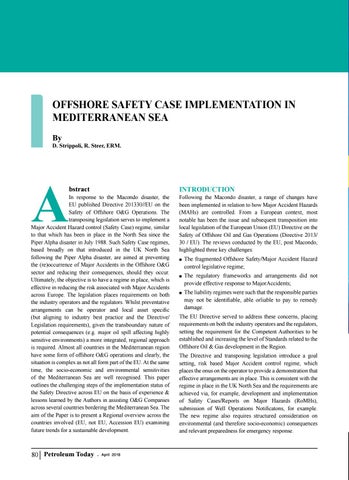OFFSHORE SAFETY CASE IMPLEMENTATION IN MEDITERRANEAN SEA By
D. Strippoli, R. Steer, ERM.
A
bstract
In response to the Macondo disaster, the EU published Directive 201330//EU on the Safety of Offshore O&G Operations. The transposing legislation serves to implement a Major Accident Hazard control (Safety Case) regime, similar to that which has been in place in the North Sea since the Piper Alpha disaster in July 1988. Such Safety Case regimes, based broadly on that introduced in the UK North Sea following the Piper Alpha disaster, are aimed at preventing the (re)occurrence of Major Accidents in the Offshore O&G sector and reducing their consequences, should they occur. Ultimately, the objective is to have a regime in place, which is effective in reducing the risk associated with Major Accidents across Europe. The legislation places requirements on both the industry operators and the regulators. Whilst preventative arrangements can be operator and local asset specific (but aligning to industry best practice and the Directive/ Legislation requirements), given the transboundary nature of potential consequences (e.g. major oil spill affecting highly sensitive environments) a more integrated, regional approach is required. Almost all countries in the Mediterranean region have some form of offshore O&G operations and clearly, the situation is complex as not all form part of the EU. At the same time, the socio-economic and environmental sensitivities of the Mediterranean Sea are well recognised. This paper outlines the challenging steps of the implementation status of the Safety Directive across EU on the basis of experience & lessons learned by the Authors in assisting O&G Companies across several countries bordering the Mediterranean Sea. The aim of the Paper is to present a Regional overview across the countries involved (EU, not EU, Accession EU) examining future trends for a sustainable development.
80 Petroleum Today
- April 2018
INTRODUCTION
Following the Macondo disaster, a range of changes have been implemented in relation to how Major Accident Hazards (MAHs) are controlled. From a European context, most notable has been the issue and subsequent transposition into local legislation of the European Union (EU) Directive on the Safety of Offshore Oil and Gas Operations (Directive 2013/ 30 / EU). The reviews conducted by the EU, post Macondo, highlighted three key challenges: Ó The fragmented Offshore Safety/Major Accident Hazard control legislative regime; Ó The regulatory frameworks and arrangements did not provide effective response to MajorAccidents; Ó The liability regimes were such that the responsible parties may not be identifiable, able orliable to pay to remedy damage. The EU Directive served to address these concerns, placing requirements on both the industry operators and the regulators, setting the requirement for the Competent Authorities to be established and increasing the level of Standards related to the Offshore Oil & Gas development in the Region. The Directive and transposing legislation introduce a goal setting, risk based Major Accident control regime, which places the onus on the operator to provide a demonstration that effective arrangements are in place. This is consistent with the regime in place in the UK North Sea and the requirements are achieved via, for example, development and implementation of Safety Cases/Reports on Major Hazards (RoMHs), submission of Well Operations Notificatons, for example. The new regime also requires structured consideration on environmental (and therefore socio-economic) consequences and relevant preparedness for emergency response.


